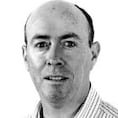An empire isn’t built in a day, not by any means. Yet, the team that has evolved around Shane Lowry has, for the most part, been constant in his time as a professional, with its genesis dating back to that storybook breakthrough win – as an amateur – in the Irish Open at Baltray in 2009.
That victory was remarkable, every bit as fanciful as Francis Ouimet’s unlikely US Open success at Brookline in 1913 which became a blockbuster movie and best-selling book, The Greatest Game Ever Played.
On that day in Co Louth Golf Club, the world and its mother seemed to descend onto the rain-soaked 18th green, but it was in the immediate mayhem that Lowry actually made one of the coolest, most calculated decisions that would shape his future.
That decision? To turn professional.
Conor Ridge, of Horizon Sports, had invited Lowry to a barbecue on the Tuesday evening before the tournament only because he was friendly with a couple of aspiring tour players from his stable – Jonny Caldwell and Gareth Shaw – from their amateur days. “It was also the first time he met Graeme McDowell, which was huge for Shane,” recalls Ridge.
Anyway, Lowry and Ridge did little more than exchange pleasantries, with some talk of perhaps getting together to talk some time down the line if and when the player was considering turning professional. The Walker Cup – later that year – was a target for Lowry, and Ridge told him that he could possibly get him an invite into the Kazakhstan Open (one of the bigger events towards the end of the Challenge Tour season) if and when he moved into the paid ranks.
Things moved far quicker than anyone could have envisaged: Lowry opened with a 67 and followed up with a 62. The amateur had started to turn heads. By Sunday evening, Lowry was champion, after defeating English professional Robert Rock in a play-off. Rock got to keep the “winner’s” cheque for €500,000; Lowry got the trophy but, as an amateur, no money.
Ridge, who’d been at a wedding on the Saturday, was back and present in Baltray on the Sunday as strains of The Offaly Rover resonated over the sandhills in celebration of Lowry’s win. Brian Cowen, Taoiseach at the time, was among the huge crowd in the galleries.
‘Bursting’
Lowry was actually among the calmest of Offalymen. Having emerged from the scorer’s cabin after his win, he spied Ridge and beckoned him over. As Ridge approached, Lowry leaned and whispered in his ear: “I don’t think I need that invite for Kazakhstan,” he said.
Ridge recalls: “Then he told me he was ‘bursting’ and he ran over to one of those portaloos that were on the course. When he came out, he high-fived me and said, ‘I’m in, let’s do this.’ I always joke we consummated our [business] marriage in a portaloo in Co Louth.”
Lowry’s business arrangement with Horizon Sports signed him up to a deal with the management agency, but some of what’s evolved into Team Lowry was already in place.
One major influence back then – and still – is his coach, Neil Manchip. The two had first got acquainted through Lowry’s immersion in the Golfing Union of Ireland’s development squad when Lowry, a late starter who only took up the sport as a 15-year-old, was quickly identified as a player of talent.
Manchip’s inspiration is huge, and goes far beyond what is perceived as the normal relationship between coach and player. The Scot is a genuine mentor to Lowry, who supervises his swing but also plays the role of sports psychologist too and invariably provides a calming presence around the player when at tournaments.
One of the changes from that famous day at Baltray relates to Lowry’s caddie. Back then, Lowry had former Offaly footballer Dave “Shaper” Reynolds on his bag and the two stayed together for his formative few weeks on tour after he decided to turn professional.
Lowry won the Irish Open in May but, by July, he identified the need for an experienced tour caddie and employed the services of Dermot Byrne, who had previously worked for Peter Lawrie.
Byrne – recognised as one of the top caddies on the circuit – has been with Lowry through his upwardly mobile graph in becoming a multi-time winner on the European Tour and then in stepping up to a new level with his win in the WGC-Bridgestone Invitational at Akron last August.
Week in, week out
Lowry trusts him implicitly. Byrne is the man by his side week in, week out on tour and Kieron O’Neill – of Horizon Sports – is his day-to-day handler and attends most tournaments, looking after his needs. It means the player can concentrate on his game.
Other important members of Lowry’s team are Shane Lawlor, a sports therapist and chiropractor, and Robbie Cannon, who is his fitness and conditioning trainer. In his weeks away from tournament play, Lowry undergoes rigorous sessions at Morton Stadium in Santry under Cannon’s supervision.
So, away from tournaments, Lowry also puts in a heavy shift through fitness regimes and practice but has also managed to play golf with friends from his amateur days.
And he also has a man-of-the-people likeability, attending GAA matches and also Leinster and Irish rugby matches whenever he can.
As Ridge says of Lowry’s popularity and his appeal, “It’s not a myth, he is a good guy.”

















